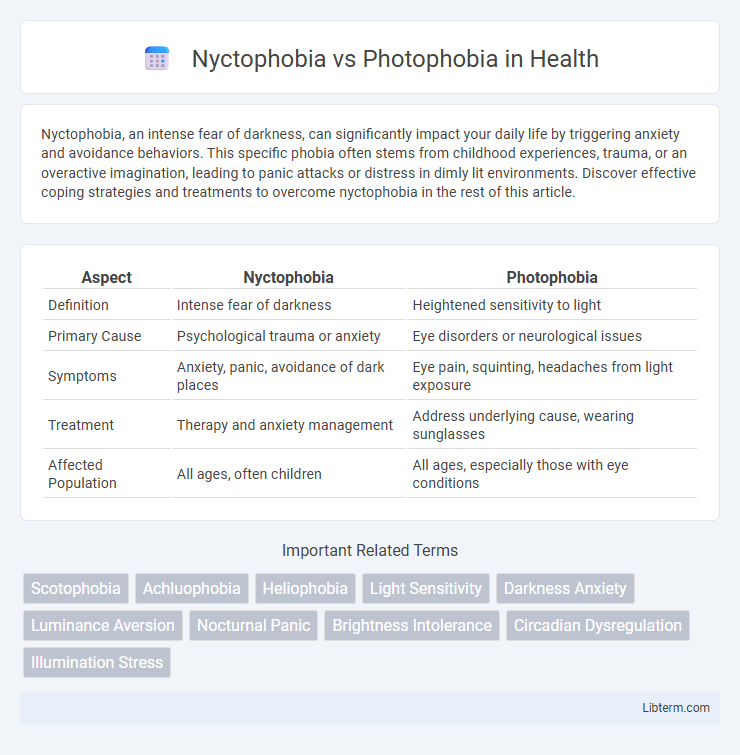Nyctophobia, an intense fear of darkness, can significantly impact your daily life by triggering anxiety and avoidance behaviors. This specific phobia often stems from childhood experiences, trauma, or an overactive imagination, leading to panic attacks or distress in dimly lit environments. Discover effective coping strategies and treatments to overcome nyctophobia in the rest of this article.
Table of Comparison
| Aspect | Nyctophobia | Photophobia |
|---|---|---|
| Definition | Intense fear of darkness | Heightened sensitivity to light |
| Primary Cause | Psychological trauma or anxiety | Eye disorders or neurological issues |
| Symptoms | Anxiety, panic, avoidance of dark places | Eye pain, squinting, headaches from light exposure |
| Treatment | Therapy and anxiety management | Address underlying cause, wearing sunglasses |
| Affected Population | All ages, often children | All ages, especially those with eye conditions |
Understanding Nyctophobia: Fear of the Dark
Nyctophobia, characterized by an intense fear of the dark, often triggers anxiety and avoidance behaviors, significantly impacting daily life. This fear stems from heightened sensitivity to darkness-related stimuli, unlike photophobia, which involves discomfort or pain from light exposure. Understanding nyctophobia involves recognizing its psychological roots, symptoms such as panic attacks or rapid heartbeat in dark environments, and differentiating it clearly from photophobia's physiological light sensitivity.
Photophobia Explained: Sensitivity to Light
Photophobia, characterized by an abnormal sensitivity to light, often causes discomfort or pain in the eyes when exposed to bright or even moderate lighting conditions. Unlike nyctophobia, which is a fear of darkness, photophobia is a physical symptom commonly associated with migraines, eye infections, or neurological disorders. Managing photophobia involves identifying underlying causes and minimizing exposure to harsh light sources through tinted lenses or environmental adjustments.
Key Differences Between Nyctophobia and Photophobia
Nyctophobia is an intense, irrational fear of darkness that triggers anxiety and panic attacks, often linked to psychological conditions, while photophobia is a sensitivity or aversion to light, causing discomfort or pain in the eyes often associated with medical issues like migraines or eye disorders. Nyctophobia primarily affects emotional and cognitive responses to darkness, whereas photophobia pertains to physical eye symptoms induced by light exposure. Effective treatment for nyctophobia centers on psychotherapy and anxiety management, whereas photophobia treatment targets underlying medical causes and light sensitivity mitigation.
Common Symptoms of Nyctophobia
Nyctophobia, the intense fear of darkness, commonly manifests through symptoms such as rapid heartbeat, sweating, trembling, and feelings of panic or dread when exposed to dark environments. These symptoms contrast with photophobia, which primarily involves an abnormal sensitivity to light causing discomfort, squinting, or eye pain. Both conditions can significantly impact daily functioning but stem from distinct underlying causes and trigger different physical and psychological responses.
Recognizing Signs of Photophobia
Photophobia is characterized by an abnormal sensitivity to light, often causing discomfort, squinting, headaches, or eye pain when exposed to bright or flickering light sources. Recognizing signs of photophobia involves noting frequent eye rubbing, excessive blinking, and avoidance of brightly lit environments or sunlight, which distinguish it from Nyctophobia, a fear of darkness. Accurate identification of photophobia symptoms is essential for proper diagnosis and treatment, especially in conditions such as migraines, eye infections, or neurological disorders.
Psychological Triggers and Causes
Nyctophobia, the fear of darkness, often stems from psychological triggers such as childhood trauma, anxiety disorders, or learned associations with unsafe environments during darkness. Photophobia, a hypersensitivity to light, is primarily caused by neurological or ophthalmological conditions like migraines, meningitis, or eye inflammation rather than purely psychological factors. Understanding the distinct psychological and physiological origins of these conditions is crucial for developing effective treatment strategies.
Physical Health Factors Involved
Nyctophobia involves an intense fear of darkness that triggers a stress response affecting autonomic nervous system functions, such as increased heart rate and cortisol levels, potentially leading to chronic anxiety and sleep disturbances. Photophobia, characterized by an abnormal sensitivity to light, often results from underlying physical conditions like migraines, eye inflammation, or neurological disorders, causing symptoms such as eye pain, headaches, and nausea. Both conditions impact physical health by disrupting normal sensory processing and can exacerbate related medical issues if left unmanaged.
Impact on Daily Life and Well-Being
Nyctophobia, an intense fear of darkness, can lead to severe anxiety, sleep disturbances, and avoidance of nighttime activities, significantly impairing daily routines and social interactions. Photophobia, characterized by sensitivity to light, often results in headaches, eye strain, and discomfort in bright environments, limiting outdoor activities and productivity. Both conditions contribute to decreased overall well-being by fostering stress and reducing quality of life through their respective sensory challenges.
Diagnosis and Assessment Methods
Nyctophobia diagnosis primarily involves clinical interviews and behavioral assessments to evaluate fear responses to darkness, with tools like the Fear Survey Schedule or specific phobia questionnaires aiding in identifying symptom severity. Photophobia assessment relies on patient history and clinical examination, including pupillary light reflex tests and neurologic evaluations to detect light sensitivity linked to underlying conditions such as migraines or ocular diseases. Both conditions may require referrals to specialists--psychologists for Nyctophobia and ophthalmologists or neurologists for Photophobia--for comprehensive diagnostic accuracy.
Effective Treatments and Coping Strategies
Effective treatments for nyctophobia often involve cognitive-behavioral therapy (CBT), exposure therapy, and relaxation techniques to reduce anxiety associated with darkness. Photophobia management typically includes addressing underlying causes such as migraines or eye conditions, using sunglasses or tinted lenses, and sometimes prescribing medications like migraine preventives or anti-inflammatory drugs. Both conditions benefit from personalized coping strategies such as gradual exposure, environmental adjustments, and stress reduction practices to improve daily functioning.
Nyctophobia Infographic

 libterm.com
libterm.com